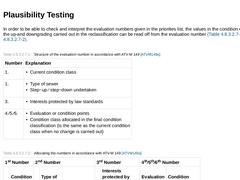
|
In order to be able to check and interpret the evaluation numbers given in the priorities list, the values in the condition evaluation and the up-and downgrading carried out in the reclassification can be read off from the evaluation number (Tabelle 4.7.2.1.6) (Tabelle 4.7.2.1.6). (Table: Structure of the evaluation number in accordance with ATV-M 149 [ATVM149a]) (Table: Allocating the numbers in accordance with ATV-M 149 [ATVM149a]) In Bild 4.7.2.1.6 |
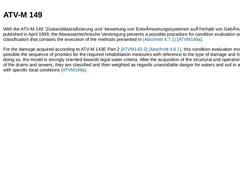
|
With the ATV-M 149 "Zustandsklassifizierung und -bewertung von Entwässerungssystemen außerhalb von Gebäuden" published in April 1999, the Abwassertechnische Vereinigung presents a possible procedure for condition evaluation and classification that contains the execution of the methods presented in Abschnitt 4.7.1 [ATVM149a]. For the damage acquired according to ATV-M 143E Part 2 [ATVM143-2] (Abschnitt 4.6.1), this condition evaluation model makes … |
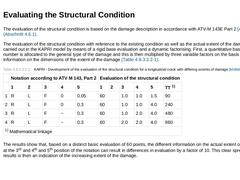
|
The evaluation of the structural condition is based on the damage description in accordance with ATV-M 143E Part 2 [ATVM143-2] (Abschnitt 4.6.1). The evaluation of the structural condition with reference to the existing condition as well as the actual extent of the damage, is carried out in the KAPRI model by means of a rigid base evaluation and a dynamic factorising. First, a quantitative base point number is allocated to the general type of the … |
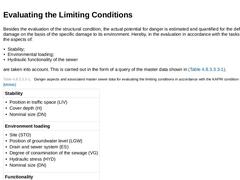
|
Besides the evaluation of the structural condition, the actual potential for danger is estimated and quantified for the defined point of damage on the basis of the specific damage to its environment. Hereby, in the evaluation in accordance with the tasks of a sewer, the aspects of: - Stability;
- Environmental loading;
- Hydraulic functionality of the sewer
are taken into account. This is carried out in the form of a query of the master data shown in Tabelle … |
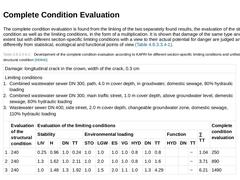
|
The complete condition evaluation is found from the linking of the two separately found results, the evaluation of the structural condition as well as the limiting conditions, in the form of a multiplication. It is shown that damage of the same type and the same extent but with different section-specific limiting conditions with a view to their actual potential for danger are judged and evaluated differently from statistical, ecological and functional … |
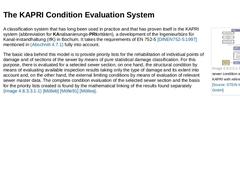
|
(Image: Diagram of sewer condition evaluation with KAPRI with reference to [Mölleb] [Image: S&P GmbH]) A classification system that has long been used in practice and that has proven itself is the KAPRI system (abbreviation for KAnalsanierungs-PRIoritäten), a development of the Ingenieurbüro für Kanal-instandhaltung (IfK) in Bochum. It takes the requirements of EN 752-5 [DINEN752-5:1997] mentioned in Abschnitt 4.7.1 fully into account. The basic idea … |
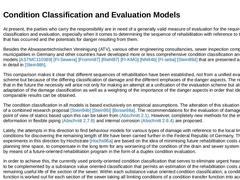
|
At present, the parties who carry the responsibility are in need of a generally valid measure of evaluation for the required condition classification and evaluation, especially when it comes to determining the sequence of rehabilitation with reference to the damage that has occurred and the potentials for danger resulting from them. Besides the Abwassertechnischen Vereinigung (ATV), various other engineering consultancies, sewer inspection companies … |
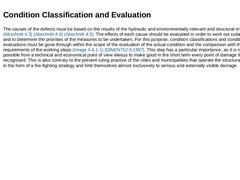
|
The causes of the defects must be based on the results of the hydraulic and environmentally relevant and structural investigations (Abschnitt 4.3) (Abschnitt 4.4) (Abschnitt 4.5). The effects of each cause should be evaluated in order to work out suitable solutions and to determine the priorities of the measures to be undertaken. For this purpose, condition classifications and condition evaluations must be gone through within the scope of the evaluation … |

|
|
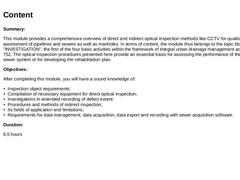
|
Summary: This module provides a comprehensive overview of direct and indirect optical inspection methods like CCTV for qualitative condition assessment of pipelines and sewers as well as manholes. In terms of content, the module thus belongs to the topic block "INVESTIGATION", the first of the four basic activities within the framework of integral urban drainage management according to EN 752. The optical inspection procedures presented here provide … |
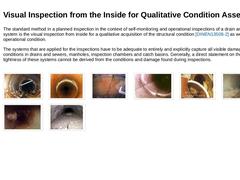
|
The standard method in a planned inspection in the context of self-monitoring and operational inspections of a drain and sewer system is the visual inspection from inside for a qualitative acquisition of the structural condition [DINEN13508-2] as well as the operational condition. The systems that are applied for the inspections have to be adequate to entirely and explicitly capture all visible damages and conditions in drains and sewers, manholes, … |
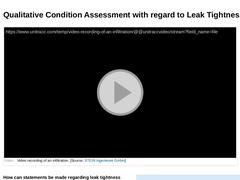
|
(Video: Video recording of an infiltration) How can statements be made regarding leak tightness within the framework of a qualitative condition assessment? The main damage group “infiltration” can only be detected in a visual inspection for the case of infiltrating groundwater or from evidence of staining due to past infiltration. For that reason, for sewers and structures that are completely or partly within the groundwater zone, it is recommended … |
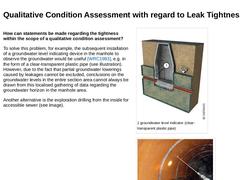
|
How can statements be made regarding the tightness within the scope of a qualitative condition assessment? To solve this problem, for example, the subsequent installation of a groundwater level indicating device in the manhole to observe the groundwater would be useful [WRC1983], e.g. in the form of a clear-transparent plastic pipe (see illustration). However, due to the fact that partial groundwater lowerings caused by leakages cannot be excluded, … |
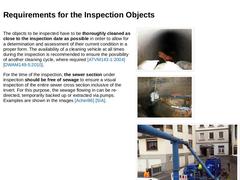
|
The objects to be inspected have to be thoroughly cleaned as close to the inspection date as possible in order to allow for a determination and assessment of their current condition in a proper form. The availability of a cleaning vehicle at all times during the inspection is recommended to ensure the possibility of another cleaning cycle, where required [ATVM143-1:2004] [DWAM149-5:2010]. For the time of the inspection, the sewer section under inspection |
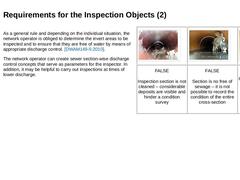
|
As a general rule and depending on the individual situation, the network operator is obliged to determine the invert areas to be inspected and to ensure that they are free of water by means of appropriate discharge control. [DWAM149-5:2010]. The network operator can create sewer section-wise discharge control concepts that serve as parameters for the inspector. In addition, it may be helpful to carry out inspections at times of lower discharge. |
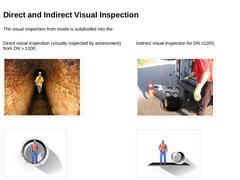
|
The visual inspection from inside is subdivided into the: Direct visual inspection (visually inspected by assessment) from DN > 1200 (Image: Accessible brick sewer) (Image: Picto Manned techniques / accessible) Indirect visual inspection for DN ≤1200
(Image: Not accessible pipe cross-section) (Image: PICTO Not accessible / unmanned) |
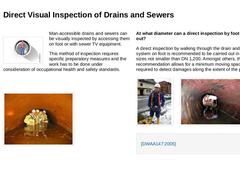
|
(Image: Begehbar) Man-accessible drains and sewers can be visually inspected by accessing them on foot or with sewer TV equipment. This method of inspection requires specific preparatory measures and the work has to be done under consideration of occupational health and safety standards. (Image: Direct inspection of a culvert) At what diameter can a direct inspection by foot be carried out? A direct inspection by walking through the drain and sewer system … |

|
(Image: Begehbar) If, despite the large diameter of the pipeline or sewer cross-section, walkability is not possible (e.g. diversion, backwater, overpumping of wastewater too expensive), the gas space can be inspected using indirect inspection. For this purpose, the inspection system is mounted on a raft, for example. Inspection systems for indirect inspection will be explained in detail later. (Image: Indirect inspection of a large profile pipe with … |
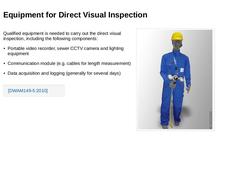
|
Qualified equipment is needed to carry out the direct visual inspection, including the following components: -
Portable video recorder, sewer CCTV camera and lighting equipment
-
Communication module (e.g. cables for length measurement)
-
Data acquisition and logging (generally for several days)
(Image: Portable sewer inspection system for walk-in sewage systems) |
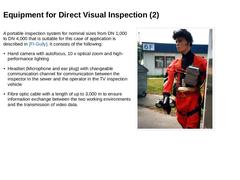
|
A portable inspection system for nominal sizes from DN 1,000 to DN 4,000 that is suitable for this case of application is described in [FI-Gully]. It consists of the following: -
Hand camera with autofocus, 10 x optical zoom and high-performance lighting
-
Headset (Microphone and ear plug) with changeable communication channel for communication between the inspector in the sewer and the operator in the TV inspection vehicle
-
Fibre optic cable with a …
|
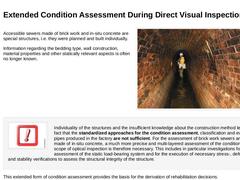
|
Accessible sewers made of brick work and in-situ concrete are special structures, i.e. they were planned and built individually. Information regarding the bedding type, wall construction, material properties and other statically relevant aspects is often no longer known. (Image: Condition evaluation by inspection in a brick work sewer - Neu) Important: Individuality of the structures and the insufficient knowledge about the construction method lead … |
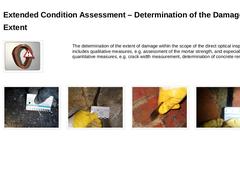
|
The determination of the extent of damage within the scope of the direct optical inspection includes qualitative measures, e.g. assessment of the mortar strength, and especially quantitative measures, e.g. crack width measurement, determination of concrete removal, etc. (Image: Recording the extent of damage - Crack width measurement) (Image: Recording the extent of damage - Crack width measurement - Bild 2) (Image: Recording … |
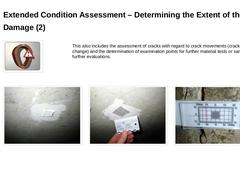
|
This also includes the assessment of cracks with regard to crack movements (crack width change) and the determination of examination points for further material tests or sampling for further evaluations. (Image: Placing a plaster mark over a crack) (Image: Removing a plaster mark over a crack) (Image: Crack mark gauge to determine the crack width development) |
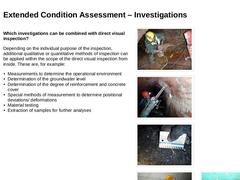
|
Which investigations can be combined with direct visual inspection? Depending on the individual purpose of the inspection, additional qualitative or quantitative methods of inspection can be applied within the scope of the direct visual inspection from inside. These are, for example: -
Measurements to determine the operational environment
-
Determination of the groundwater level
-
Determination of the degree of reinforcement and concrete cover
-
Special …
|
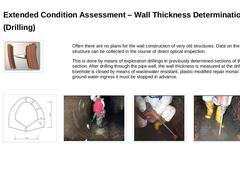
|
(Image: Icon Mauerwerk Wanddicke) Often there are no plans for the wall construction of very old structures. Data on the wall structure can be collected in the course of direct optical inspection. This is done by means of exploration drillings in previously determined sections of the cross section. After drilling through the pipe wall, the wall thickness is measured at the drill. The borehole is closed by means of wastewater resistant, plastic-modified … |